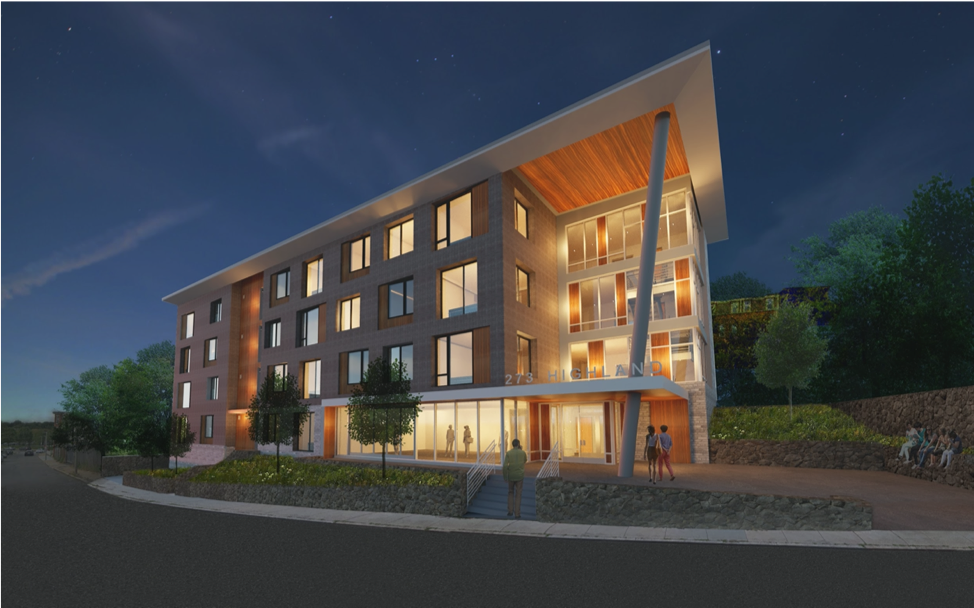ILFI Announces New Affordable Housing Pilot Projects
Cover image: 350 China Street in San Francisco, CA. Rendering courtesy of Mithun
Editor’s note: ILFI has green building solutions for everyone, everywhere. If you’re interested in being part of our work to ensure affordable, healthy, sustainable housing for all, join our upcoming members-only Affordable Housing Showcase event on Thursday, March 18! Members can register in their Member Dashboard login. To sign up for membership & join the event, click here. You can also subscribe to our monthly newsletter, attend our Living Future Unconference, or consider making a charitable contribution to this critical work that impacts thousands of families around the country. Reach out to us at affordablehousing@living-future.org to register your affordable housing project for the Living Building Challenge or for more information about our affordable housing resources.
The International Living Future Institute (ILFI) is excited to announce that 20 new affordable housing projects have signed up to pursue the Living Building Challenge, as well as the Core Green Building, Zero Carbon, and Zero Energy Certifications. These 20 projects join 27 others that are part of ILFI’s Affordable Housing Program. Over the next three years, these projects will receive extra support from ILFI to aid in their pursuit of healthy, sustainable housing and ILFI certification. This support comes in the form of assistance with charrettes, feasibility reports, educational sessions, opportunities for peer-to-peer informational exchange, and additional access to support and resources.
The peer-to-peer exchange among teams with similar goals is an important aspect of the program. Members from all the Affordable Housing Pilot Projects meet monthly to learn and support each other in their pursuit of Living Affordable Housing. To provide further opportunities for informational exchange and discussion among teams, ILFI launched a series of small working groups in January of this year. Each group will investigate one topic in detail and work together to share information, discuss barriers, and find solutions. The topics are:
- Materials: Red List Free, FSC, and Declare
- Embodied Carbon and Energy
- Community Land Trust and Limited Equity Projects
- Modular Construction as a Tool for Sustainability
- LBC Strategies for Lower-Density Housing

Living Proof
ILFI’s Affordable Housing Program was created with the primary goal of demonstrating that Living Affordable Housing is possible. There are now nearly 50 affordable housing projects pursuing certification under ILFI’s programs, which are the world’s most ambitious and impactful green building certifications. Four affordable housing projects have already been certified under ILFI’s Zero Energy program, and many more are in construction or in their 12-month performance period and will come in for certification under Zero Energy, Petal, or Living Certification in the next several years. These projects are proving Living Affordable Housing is possible.
The goal now is to scale the work and impact, and to make Living Affordable Housing the norm across the country. Everyone deserves to live in housing that is healthy, sustainable, resilient, and affordable. Through its Affordable Housing Program, ILFI is partnering with these 20 new projects to create living proof of what is possible. The leadership they demonstrate, the example they set, and the lessons they provide are helping to create resources that will transform the industry showing a path to Living Buildings for all!
A core purpose of ILFI’s Affordable Housing Program is to capture the lessons learned from these pilot projects to create resources that will benefit the entire affordable housing industry. Many valuable resources have already been developed to help other affordable housing teams pursuing the Living Building Challenge and other ILFI certifications. These include: the Living Building Challenge Framework for Affordable Housing (now in its second version), the Materials List for Affordable Housing (a living resource that is growing in content and impact overtime), Guide for Greener QAPs, case studies, and other resources that can all be downloaded for free from the Affordable Housing Program’s webpage.
Scaling Impact
These 20 new pilot projects are helping to significantly scale ILFI’s affordable housing work. They bring increased diversity of geographic location, project scale and type, as well as developer reach.
The new projects are located in 10 different states, spanning from Oregon to Alabama to Maine, and are located both in urban centers and rural areas. Seven projects will be located in the San Francisco Bay Area of California, a stand-out region for this work, led by developers such as Tenderloin Neighborhood Development Corporation, who has registered four new projects. The Bay Area’s work is also being led by designers, such as David Baker Architects, who designed two other Living Building Challenge affordable housing pilot projects now under construction in San Francisco and Oakland. A goal of this phase of our program is to continue to build off the strong work done in regions such as the San Francisco Bay Area, while expanding to other regions. Nine of the new projects are located in states that have not previously hosted pilot projects, including Alabama, North Carolina, Maine, Pennsylvania, Massachusetts, New York, and Oregon.
In addition to geographic diversity, the projects also represent a range of scales, building types, and future occupants. The largest project will be roughly 200,000 square feet while the smallest project will be a little over 10,000 square feet. The projects represent both rental and homeownership projects and include single-family homes, townhomes, duplexes, and multi-family buildings for families, seniors, low-income healthcare workers, special needs populations, veterans, and previously homeless individuals. The projects include not just housing, but also needed services such as childcare facilities, elder healthcare clinics, learning centers, grocery, and community commercial space.
The new projects also represent a broad range of developers, including two public housing authorities and several large affordable housing developers that operate nationwide. The pilot projects from these developers have the opportunity to inform how affordable housing is created moving forward across their entire portfolios.
These projects are also helping to scale impact. The four affordable housing projects that are currently certified have achieved Zero Energy Certification. Seventeen of the newest 20 projects have registered under the Living Building/Petal or Core programs. (ILFI’s newest certification, the Core Green Building Certification allows for project teams to maximize their impact across Imperatives and is the pathway chosen by half of the project teams.) These holistic certification pathways will allow the project teams to demonstrate performance in areas that have long been important to affordable housing developers including water efficiency and reuse, healthy materials, community spaces, providing access to nature and healthy food, and equity. Two projects are pursuing Zero Carbon Certification. Embodied carbon reduction has traditionally not been a priority of affordable housing developers, but many are now looking to choose low-carbon options for concrete and other high-impact materials, as well as reduce the overall materiality of projects to reduce carbon impacts along with costs.
The next three years of ILFI’s affordable housing work will help to greatly increase the Red List Free materials accessible for affordable housing teams, provide pathways for teams to pursue Core and Zero Energy Certifications at scale, demonstrate case studies for Living Building Certification, and investigate how embodied carbon strategies can work to bring down costs for affordable housing.
Project Highlights
31 Tufts Street
The 31 Tufts Street project in Somerville, Mass., is modeled as Zero Energy, and the team is pursuing Zero Carbon strategies to prove that a cost-effective model for Zero Carbon affordable housing is attainable. The team, led by Placetailor Architects and the owner E3 Development, LLC, is committed to providing high-quality housing units with a focus on improved indoor air quality and access to green space while also providing long-term energy efficiency.
Providence Generations
Another project focused on health is Providence Generations in Issaquah, Wash. This project is under development by Providence Supportive Housing and is located on a master-planned health care campus, with the intention to provide convenient, affordable housing for low-income health care workers. As referenced in the project name, the building will also connect generations by providing housing for very low-income seniors and families with young children, as well as services such as child care and an elder clinic. With a project mission to promote “better health for the world,” the project team is using the Living Building Challenge as a framework to promote more equitable health outcomes.
Hazelwood Community Land Trust and Alma Street Commons
The Hazelwood Community Land Trust and Alma Street Commons are both being developed by land trust organizations and will be providing homeownership opportunities for low-income residents of Pittsburgh and Durham, North Carolina, respectively. These projects provide the potential to provide a scalable model for Core-certified buildings
Tenderloin Neighborhood Development Corporation
The Tenderloin Neighborhood Development Corporation (TNDC), one of the largest affordable housing developers in San Francisco, has registered four projects, which are pursuing a range of certifications including Zero Carbon, Materials Petal within the Living Building Challenge, and Core. TNDC has committed to creating healthier materials specifications and has encouraged their project teams to work together and with other organizations to help identify Red List Free and FSC certified materials that can be added to their common spec.
Timber Ridge
Timber Ridge is being developed by the Northeast Oregon Housing Authority in rural La Grande, OR. Rural areas also face housing shortages and can present even greater challenges for building and sourcing sustainably. This project, one of two being developed by public housing authorities, will provide a model for overcoming these barriers and plans to certify under the Energy Petal within the Living Building Challenge. Similar to Providence Generations, this project will also create an intergenerational community by housing both families and seniors.
You can read more about these projects and all of the other ILFI Affordable Housing Pilot Projects on ILFI’s website.
To learn more about Affordable Housing projects, join our upcoming members-only Affordable Housing Showcase event on Thursday, March 18! Members can register in their Member Dashboard login. To sign up for membership & join the event, click here.


